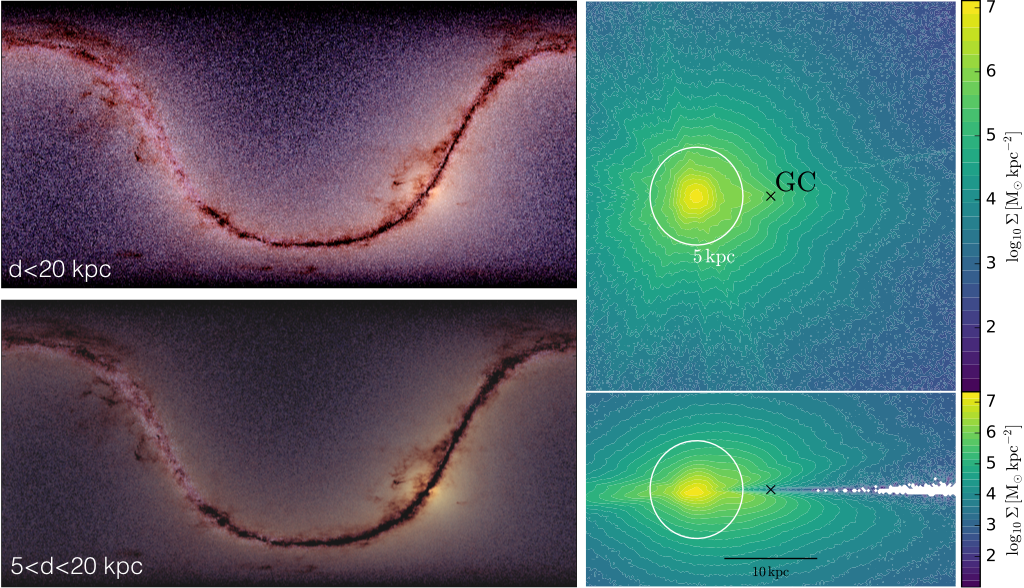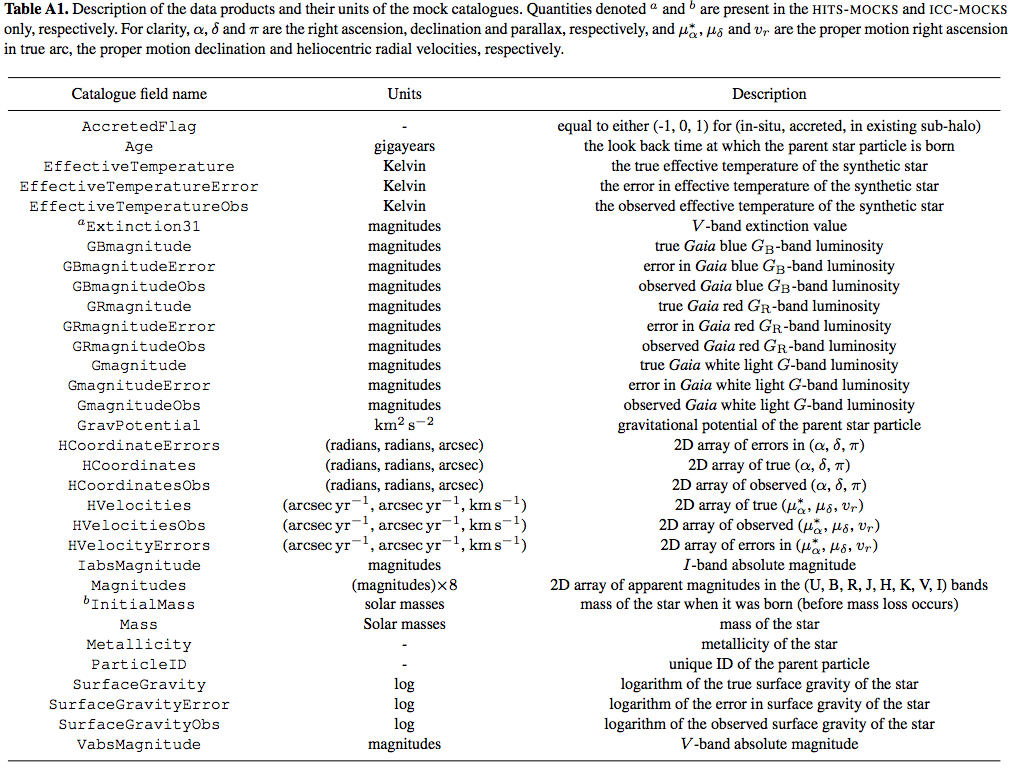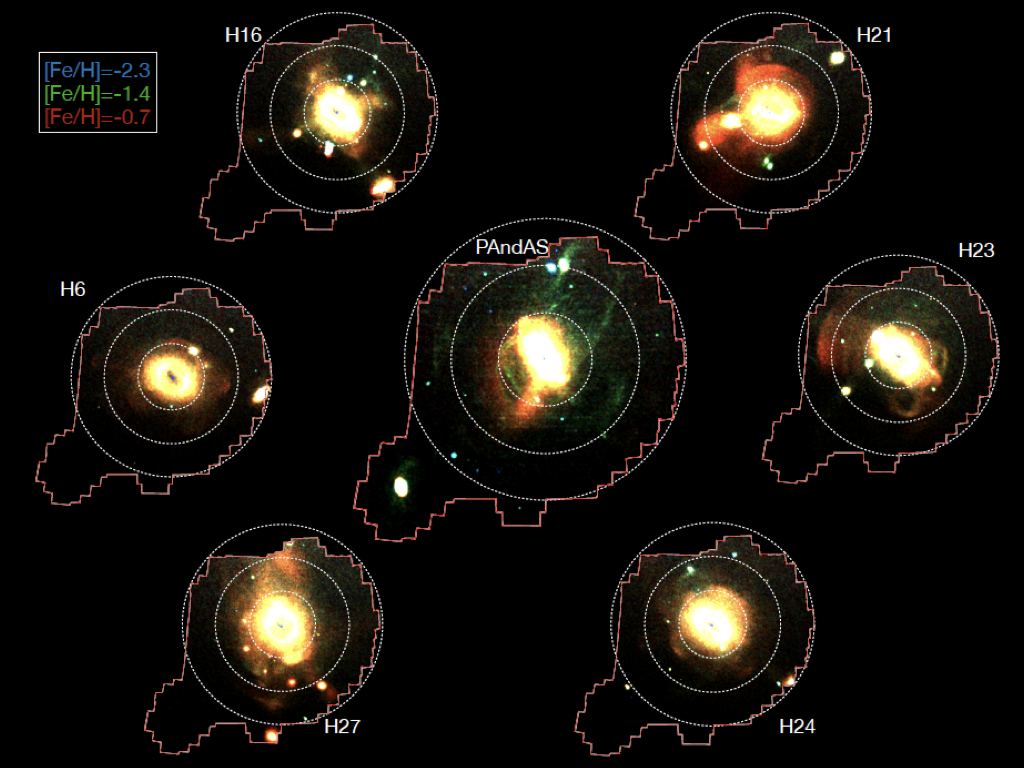Mock catalogues in a Cosmological context
We have produced synthetic stellar catalogues for both the Gaia (Milky Way) and PAndAS (Andromeda) surveys, based on the high-resolution Auriga simulations. These catalogues are imaginatively named AuriGaia and AuriPAndAS.
This page contains information and documentation on how to use the catalogues, in addition to links to download the data, supplementary material such as gravitational potential grids, and example scripts that can be used to read and extract relevant data. A complete description of the procedures used to generate these catalogues, a description of the public data products, and some interesting results can be found in the AuriGaia and AuriPAndAS publications.
AuriGaia:- Cosmological Mock catalogues for Gaia
Our view of the Milky Way galaxy is rapidly advancing thanks to the European Space Agency's cornerstone Gaia mission. Currently, the 2nd Gaia data release (DR2) contains astrometric and 3-band photometric data for around 1.4 billion sources across the whole sky, with a significant subset of these stars with radial velocity, extinction and effective temperature measurements. This provides an unprecendented look at the stellar disc and halo of the Milky way.
To help understand and interpret these observations, we have generated synthetic stellar catalogues from our high-resolution simulations designed to match the volume, accuracy and data products provided by Gaia DR2.

We have generated mock catalogues for 6 high-resolution Auriga simulations: Au 6; Au 16; Au 21; Au 23; Au 24 and Au 27 (in the nomenclature of Grand et al. 2017). For each simulation, we compute mock catalogues for 4 different solar positions, each at a radius of 8 kpc and a height of 20 pc. The four azimuthal positions are distributed equally along the 8 kpc circle. Our fiducial azimuth is defined to be 30 degrees behind the major axis of the bar, in agreement with current estimates. As there are 4 equally distributed azimuth positions, there are 2 diametrically opposed mocks per halo at an angle of 30 degrees behind the bar.
For each solar position in each Auriga simulation, we compute 2 sets of mock catalogues:
- HITS mocks: generated using a modified version of the publicly available SNAPDRAGONS code (Hunt et al. 2015, MNRAS, 450, 2132)
- ICC mocks: generated using a method based on (Lowing et al. 2015, MNRAS, 446, 2274)
A description of the data fields and their units are given in the table below taken from the appendix of Grand et al. 2018 submitted.

Downloading the data
All the mock data are available to download here, and a basic python script to read the data is available here. We provide also some scripts to make some plots we presented in the paper here.
We have set up a querying system which accepts ADQL scripts and retrieves subsets of data. This can be accessed via this link, under the database name 'Grand2018a'. The table names are of the form [H|I]_AuXX_LY_AngleZZZ_[No]Ext where the I or H indicates ICC or HITS mocks, XX identifies the halo, Y is the resolution level (always 3 at the moment) and ZZZ is the orientation. **Note that only the angle 030 degrees is available to query on the database for each simulation. Other angles must be downloaded using the link in the paragraph above.**
An example query to retrieve stars with G<13 mag within 5 kpc of the Sun for the fiducial HITS mock of halo Au 6 is:
select
Gmagnitude, RA, Dec, Parallax
from
Grand2018a..H_Au06_L3_Angle030_Ext
where
Gmagnitude < 13.0 and 1.0/Parallax < 5000.0
Users are required to acquire a database account to use the system, which can be requested by filling in the form at the Virgo Database webpage.
3-dimensional force and potential grids
Three dimensional grids of the gravitational potential and forces for all 6 simulations. We have prepared a course, polar grid and a fine, cartesian grid that covers the central galaxy. The coarse polar grid 160 logarithmically spaced between 10 kpc and 300 kpc, with 300 and 150 bins in azimuth and latitude, respectively. The fine cartesian grid is of 21 kpc side-length with a spatial resolution of 125 pc (which is comparable to the softening length of the simulation).
The grids are available to download below:
A simple script to read the grids is provided here. In this script, one can see how the grids are read into the correct coordinates, and check the information on the units of the output.
AuriPAndAS:- Mock catalogues for the PAndAS M31 survey
The Pan-Andromeda Archaeological Survey PAndAS covers more than 400 square degrees around the Andromeda galaxy, resolving substructure and the spatial distribution of metals in and around the disc and halo.
We have processed the Auriga galaxies through a newly-developed Auriga2PAndAS pipeline, and created PAndAS-like mocks that fold in all observational limitations of the survey data (foreground contamination from the MilkyWay stars, incompleteness of the stellar catalogues, photometric uncertainties, etc), as depicted in the image below.

FITS files containing data products of a single realisation of an AuriPAndAS mock for each of the 6 high-resolution simulations is available to download using the links below: